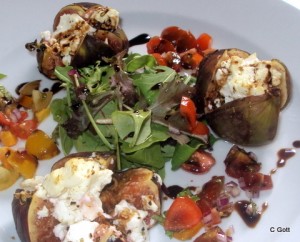For many people of my parents generation their experience of figs used to come baked in a small sweet pastry case the ubiquitous ‘ fig roll ‘. Now I am all for a fig roll, they are quite moreish with a hot cuppa, but today most people have access to the fresh fruit. The fresh fig is far from as humble as our little biscuit, throughout history the fig has been worshipped as a powerful aphrodisiac. In pictorial representation Adam and Eve are clothed in the fig’s leaves, it is said to haven been Cleopatra’s favourite fruit and heavens above I don’t even want to go into the symbolism that runs through the D.H Lawrence poem. They are a particularly high source of iron and potassium but I don’t know if that has any causal link with their supposed qualities.
So how does one tackle a fig ? Some people find the texture can be a little off-putting ( maybe they read D.H.Lawrence ), so I would stew them down to a sticky, sweet compote with a little orange zest and a Star Anise pod. The result is delicious stirred into thick Greek style yogurt, if you have a sweet tooth you can grill them, drizzled with honey, then spoon in some chilled Mascarpone and sprinkle with chopped nuts and chocolate shavings for the easiest of desserts . For the more savoury minded why not settle down to a plate of figs, Manchego cheese, fine Iberico ham and a chilled glass of Fino sherry or simply figs and Prosciutto.
Perhaps the most popular fig dish you will see on high street bistros and restaurant menus is the classic combination baked with Goats cheese. So here is my simple take with a little tomato and olive oil salsa style dressing and a Balsamic reduction. Use two figs as a rich, indulgent starter or three for a filling lunchtime snack. The Balsamic quantities are rather generous but it is easier to make in larger quantities, smaller amounts tend to burn, it is great to have around as a simple salad dressing, to accompany grilled lamb cutlets or just a splash or two on ripe strawberries. The size of the cup is not important just use the same measure each time.
 Baked Figs with Honey and Balsamic Reduction serves 4 for lunch
Baked Figs with Honey and Balsamic Reduction serves 4 for lunch
8 Ripe Figs
3 Soft Crottin de Chavignol
2 Handfuls of mixed Salad Leaves, washed and thoroughly dried
( Rocket, Baby Spinach, Lamb’s Tongue, Curly Endive )
12 Mixed Baby Tomatoes, Cherry, Plum and Yellow
1 Very small Red Onion, peeled and very finely diced
2 tablespoons of the best quality Extra Virgin Olive Oil
½ teaspoon Caster Sugar
Sea Salt and freshly ground Black Pepper
For the Balsamic Reduction
1 Cup of good Balsamic Vinegar
1 Cup Honey
½ Cup Oloroso ( Nutty ) Sherry
To make the dressing place the ingredients into a small, heavy bottomed pan and gently heat. Stir until the honey dissolves then bring up to a gentle simmer. Reduce by half and leave aside to thoroughly cool. The result should be a dark, glossy syrup which you can store in the fridge in a sterilised, airtight container. Before use remove from the fridge and bring up to room temperature.
For the Baked Figs
Preheat your oven to 350 F / 180 C / Gas Mark 4. Carefully cut the figs into quarters, from the top almost to the base, and arrange on a non-stick baking tray. With your fingers break up the goat’s cheese and divide between the figs. Place in the oven and bake for ten to fifteen minutes until the cheese is melted and tinged brown.
While the figs are baking cut up the tomatoes and place in a small bowl. Add the finely diced onion then sprinkle with the caster sugar and season generously. Mix together thoroughly. When the figs are done add the olive oil to the tomatoes and mix once more. To serve place the salad leaves in the centre of the plate and circle with the simple tomato salsa. Carefully place one the baked figs and using a teaspoon flick over some Balsamic reduction. Enjoy.
